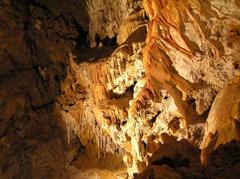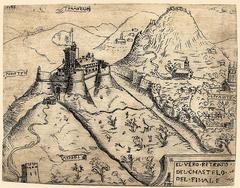
Visiting Via delle Sevore in Finale Ligure: Hours, Tickets, and Historic Sites
Date: 18/07/2024
Introduction
Via delle Sevore, nestled in the heart of Finale Ligure, Italy, is a captivating historical street that offers visitors a unique glimpse into the rich tapestry of the region’s past. This ancient roadway has witnessed significant historical events, from its early days under Roman influence to its medieval strategic importance, and subsequent architectural flourishes during the Renaissance and Baroque periods. Today, Via delle Sevore stands as a testament to Finale Ligure’s enduring cultural heritage, blending historical charm with modern-day attractions. This guide aims to provide a comprehensive overview of Via delle Sevore, encompassing its historical significance, visitor information, and nearby attractions, ensuring that travelers have all the tools they need for an enriching visit. Whether you’re a history enthusiast, an outdoor adventurer, or simply looking to immerse yourself in the local culture, Via delle Sevore has something to offer (Finale Ligure Official Tourism).
Table of Contents
- Introduction
- Ancient Roots and Roman Influence
- Medieval Significance
- Renaissance and Baroque Periods
- Modern Era and Preservation Efforts
- Visitor Information
- Cultural Significance and Modern-Day Relevance
- FAQ
- Conclusion
- References
Ancient Roots and Roman Influence
Via delle Sevore, located in the picturesque town of Finale Ligure in Italy, has a rich historical tapestry that dates back to ancient times. The region of Finale Ligure itself was a significant area during the Roman Empire, known for its strategic location along the Ligurian coast. The ancient Roman road network, which included the Via Aurelia, played a crucial role in connecting the region to other parts of the empire. This connectivity facilitated trade, military movements, and cultural exchanges, laying the groundwork for the development of roads like Via delle Sevore.
Medieval Significance
During the medieval period, Finale Ligure became a focal point of various power struggles and territorial disputes. The area was under the influence of the powerful Del Carretto family, who were the marquises of Finale. The Del Carretto family fortified the region, constructing castles and defensive structures to protect their domain. Via delle Sevore likely served as a crucial route for transporting goods and troops between these fortifications and the surrounding areas.
The medieval period also saw the rise of the Republic of Genoa, which sought to expand its influence along the Ligurian coast. The strategic importance of Finale Ligure and its roadways, including Via delle Sevore, made it a contested area between the Genoese and the Del Carretto family. This period of conflict and consolidation significantly shaped the development and significance of the region’s infrastructure.
Renaissance and Baroque Periods
The Renaissance and Baroque periods brought about significant changes in the architectural and cultural landscape of Finale Ligure. The town experienced a period of prosperity and growth, which was reflected in the construction of grand buildings, churches, and public spaces. Via delle Sevore, as part of the town’s infrastructure, would have been an essential route for accessing these new developments.
One notable structure from this period is the Basilica of San Biagio, constructed in the 17th century. The basilica is an excellent example of Baroque architecture and is located near Via delle Sevore. The road would have been a vital artery for pilgrims and visitors traveling to the basilica, further cementing its importance in the town’s layout.
Modern Era and Preservation Efforts
In the modern era, Finale Ligure has become a popular tourist destination, known for its beautiful beaches, historic sites, and outdoor activities. Via delle Sevore has retained its historical charm and continues to be a significant part of the town’s cultural heritage. Efforts to preserve and maintain the historical integrity of the area have been undertaken by local authorities and heritage organizations.
The preservation of Via delle Sevore and other historical sites in Finale Ligure is crucial for maintaining the town’s unique character and attracting visitors interested in its rich history. These efforts include the restoration of ancient buildings, the maintenance of cobblestone streets, and the promotion of cultural events that celebrate the town’s heritage.
Visitor Information
Visiting Hours: Via delle Sevore is accessible to visitors 24/7, but it’s best to explore during daylight hours for safety and better visibility.
Tickets: There is no entrance fee to walk along Via delle Sevore. However, some nearby attractions might have their own ticketing requirements.
Travel Tips: Comfortable walking shoes are recommended due to the cobblestone streets. Consider carrying a map or using a navigation app to explore the area more efficiently.
Accessibility: While most of Via delle Sevore is pedestrian-friendly, some parts might be challenging for visitors with mobility issues due to uneven surfaces.
Guided Tours: Local tour operators offer guided walking tours that include Via delle Sevore, providing historical insights and interesting anecdotes.
Photographic Spots: The street itself, with its charming architecture and historical ambiance, provides numerous photo opportunities. Don’t miss the view near the Basilica of San Biagio.
Cultural Significance and Modern-Day Relevance
Today, Via delle Sevore is not just a historical artifact but a living part of Finale Ligure’s cultural fabric. The road is lined with charming shops, cafes, and residences that reflect the town’s blend of historical and modern influences. Visitors walking along Via delle Sevore can experience a sense of stepping back in time while enjoying the amenities and attractions of a contemporary tourist destination.
The road also serves as a gateway to exploring the broader historical and cultural landscape of Finale Ligure. Nearby attractions include the Archaeological Museum of Finale, which houses artifacts from the region’s ancient past, and the Castel Gavone, a medieval castle that offers stunning views of the surrounding area. These sites, along with Via delle Sevore, provide a comprehensive glimpse into the rich history and cultural heritage of Finale Ligure.
FAQ
Q: What are the visiting hours for Via delle Sevore? A: Via delle Sevore is accessible to visitors 24/7, but it’s best to explore during daylight hours for safety and better visibility.
Q: Do I need to buy tickets to visit Via delle Sevore? A: There is no entrance fee to walk along Via delle Sevore. However, some nearby attractions might have their own ticketing requirements.
Q: Are there guided tours available? A: Yes, local tour operators offer guided walking tours that include Via delle Sevore, providing historical insights and interesting anecdotes.
Q: Is Via delle Sevore accessible for visitors with mobility issues? A: While most of Via delle Sevore is pedestrian-friendly, some parts might be challenging due to uneven surfaces.
Q: What are some must-see spots near Via delle Sevore? A: Nearby attractions include the Basilica of San Biagio, the Archaeological Museum of Finale, and Castel Gavone.
Conclusion
Via delle Sevore in Finale Ligure is more than just a historical roadway; it’s a living testament to the town’s rich cultural heritage. Whether you’re a history enthusiast or a casual traveler, a visit to Via delle Sevore offers a unique blend of the past and present. Don’t forget to download our mobile app Audiala for more travel tips, and follow us on social media for the latest updates on historical sites around the world.
For more information on the historical significance of Finale Ligure and its attractions, you can visit the Finale Ligure Official Tourism.

